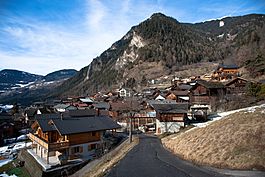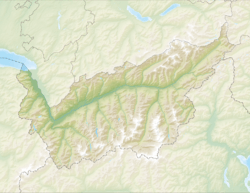Bagnes facts for kids
Quick facts for kids
Bagnes
|
||
|---|---|---|

Cotterg, a village of Bagnes.
|
||
|
||
| Country | Switzerland | |
| Canton | Valais | |
| District | Entremont | |
| Area | ||
| • Total | 282.3 km2 (109.0 sq mi) | |
| Elevation
(Le Châble)
|
820 m (2,690 ft) | |
| Population
(December 2019)
|
||
| • Total | 8,144 | |
| • Density | 28.849/km2 (74.718/sq mi) | |
| Postal code |
1934 (Le Châble)
|
|
| Localities | Val de Bagnes, Bruson, Champsec, Cotterg, Fionnay, Le Châble, Les Morgnes, Lourtier, Medières, Mauvoisin, Montagnier, Prarreyer, Sarreyer, Verbier, Versegères, Villette | |
| Surrounded by | Vollèges, Sembrancher, Saxon VS, Riddes, Nendaz, Hérémence, Evolène, .. (Italy), Bourg-Saint-Pierre, Liddes, Orsières | |
Bagnes was once a municipality (like a town or local government area) in the Valais region of Switzerland. On January 1, 2021, Bagnes and another municipality called Vollèges joined together. They formed a new, bigger municipality named Val de Bagnes.
Bagnes used to be the largest municipality in Switzerland by area. It covered about 282 square kilometers (109 square miles). This was true until 2011, when a new, larger municipality called Glarus Süd was formed.
Contents
History of Bagnes
Bagnes was first mentioned in old records around the year 1150. Back then, it was known as Banie. It also had a German name, Bangis, but that name is not used anymore.
Before 1150, the area of Bagnes was owned by the Counts of Savoy. Later, it became part of the Abbey of Saint-Maurice, a religious community. Bagnes stayed under the abbey's control until 1798. After that, it became part of the Entremont district.
The castle in Verbier, sometimes called the abbaye, was first mentioned in 1287. It was likely destroyed in 1476.
During the 1800s, people in the villages had strong disagreements about politics. This led to a conflict in 1844 called the battle of Corberaye. As a result, a new school was started in 1900. This school, called the liberal-radical free school, did not teach religion. This was different from other village schools that were run by religious groups. The free school stayed open until 1943.
The local church, or parish, was first mentioned in 1178. Its main church was St. Martin's in Le Châble. Over the years, other small chapels were built in different villages like Montagnier and Sarreyer.
The municipality often faced natural disasters, especially floods from the Dranse river. Big floods happened in 1469, 1595, and a very bad one in 1818. People also mined for silver in the area for many years.
In 1958, the Lac de Mauvoisin Dam was built. This dam, along with more and more tourists visiting, greatly changed the villages. The local economy shifted from farming to mostly services, like hotels and shops for visitors.
Until 1957, Bagnes was a group of villages that worked together loosely. Each village had its own local council until 1971.
Le Châble: A Key Village
From the 1100s, Le Châble was the main administrative center for the whole Val de Bagnes area. The Verbier castle, also known as the abbaye, was first mentioned in 1287. It was called the abbaye because it was where the Abbey of Saint-Maurice's representative lived.
In 1410, the castle was rebuilt to be a home for the abbots (leaders of the abbey). But in 1476, villagers partly destroyed it. Later, in the 1900s, the municipality bought the castle.
The front of the St. Mauritius church, built in a late Gothic style, was finished in 1520. Its choir (the part of the church where the singers sit) was done in 1534.
In 1953, Le Châble got a railway connection. This made it easier for people and goods to travel to and from the village.
Geography of Bagnes
Bagnes covered about 282.2 square kilometers (109 square miles). A small part of this land, about 15.5%, was used for farming. Forests covered 12.5% of the area. About 1.9% of the land had buildings or roads, and a large part, 70.1%, was unproductive land like mountains or glaciers.
The municipality included the main village of Le Châble. It also had many other villages and small settlements, such as Villette, Bruson, and the famous resort of Verbier.
The large reservoir called Lac de Mauvoisin is also located in the Bagnes area.
Coat of Arms
The blazon (description) of Bagnes's municipal coat of arms is: Azure, two Men proper in a Bath-tub Or. This means it shows two men in a golden bathtub on a blue background.
People of Bagnes
In 2019, Bagnes had a population of 8,144 people. About 26.3% of the people living there in 2008 were foreign nationals. Over ten years (1999–2009), the population grew by 24.3%. Most of this growth was from people moving into the area.
Most people in Bagnes speak French as their first language (about 87.4% in 2000). Portuguese was the second most common language, followed by English. Some people also spoke German or Italian.
In 2000, about 53.7% of the people living in Bagnes were born there. Another 11.4% were born in the same canton (Valais). About 21.8% were born outside of Switzerland.
The population's age distribution in 2000 showed that children and teenagers (0–19 years old) made up 22.2%. Adults (20–64 years old) were 62.3%, and seniors (over 64 years old) were 15.5%.
Important Heritage Sites
The Alpage (alpine pasture) de Louvie and the Church of St-Maurice are very important. The church includes an ossuary (a place where bones are stored) and the old rectory (the priest's house). These are listed as important Swiss heritage sites.
Several villages in Bagnes, like Bruson, Le Châble, Médières, and Sarreyer, are also part of the Inventory of Swiss Heritage Sites. This means they have special historical or cultural value.
Economy
In 2010, the unemployment rate in Bagnes was 3.9%. The economy was divided into three main parts:
- Primary sector: This includes jobs like farming and forestry. In 2008, about 282 people worked in this sector.
- Secondary sector: This includes jobs in manufacturing and construction. About 1,017 people worked here.
- Tertiary sector: This is the largest sector and includes jobs in services, like tourism, hotels, restaurants, shops, and healthcare. About 2,525 people worked in this sector.
Many people in Bagnes worked in tourism, especially in hotels and restaurants. In 2008, about 540 jobs were in hotels or restaurants.
In 2000, about 590 workers came into Bagnes for work, while 501 residents left to work elsewhere. This means more people came to Bagnes for jobs than left. About 10.4% of workers used public transportation, and 53.8% used a private car to get to work.
Religion
According to the 2000 census, most people in Bagnes were Roman Catholic (about 79.1%). About 6.6% belonged to the Swiss Reformed Church (a Protestant church). Smaller numbers of people belonged to other Christian churches, or were Muslim or Jewish. About 6.66% of the population did not belong to any church.
Education
In Bagnes, about 36.1% of the population had finished upper secondary education (like high school). About 11.0% had gone on to higher education, such as university or a specialized college.
In 2000, 67 students from other municipalities came to Bagnes for school. At the same time, 166 residents of Bagnes went to schools outside the municipality.
Transport
The municipality has a railway station called Le Châble VS. This station is on the Martigny–Orsières line, which connects it to other towns.
Notable People from Bagnes
- Francis A. Deleglise (1835–1894), who founded the town of Antigo, Wisconsin in the United States, was born in Bagnes.
- Roland Collombin, a famous skier who won two World Cup downhill championships and an Olympic silver medal, was born and still lives in Versegères, a village in Bagnes.
- Marie Troillet, a Swiss ski mountaineer (someone who climbs and skis mountains), was born in Bagnes.
- Joseph Vaudan (1925 - 2008), a Catholic priest who helped start commercial wine making in Valle d'Aosta, Italy.
Images for kids
See also
 In Spanish: Bagnes para niños
In Spanish: Bagnes para niños





